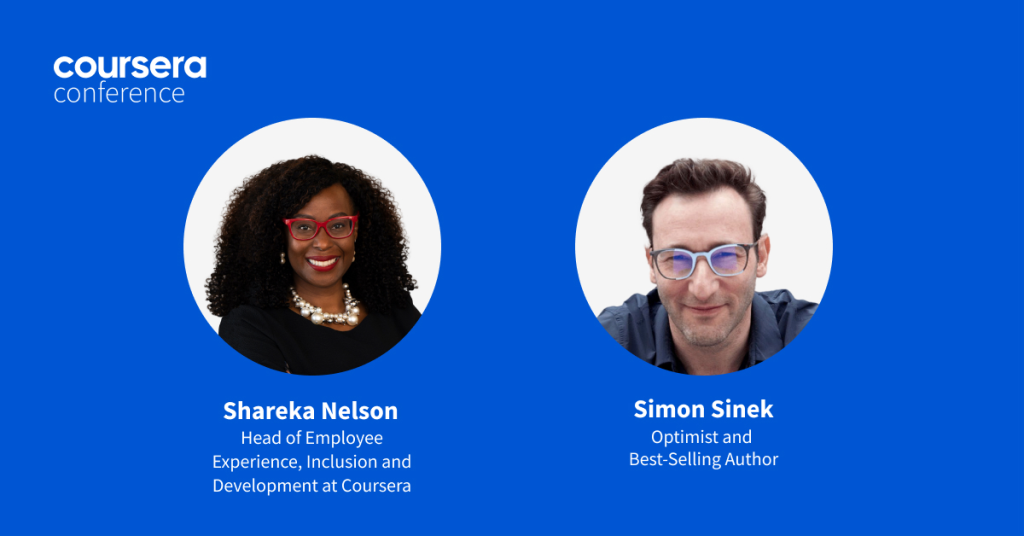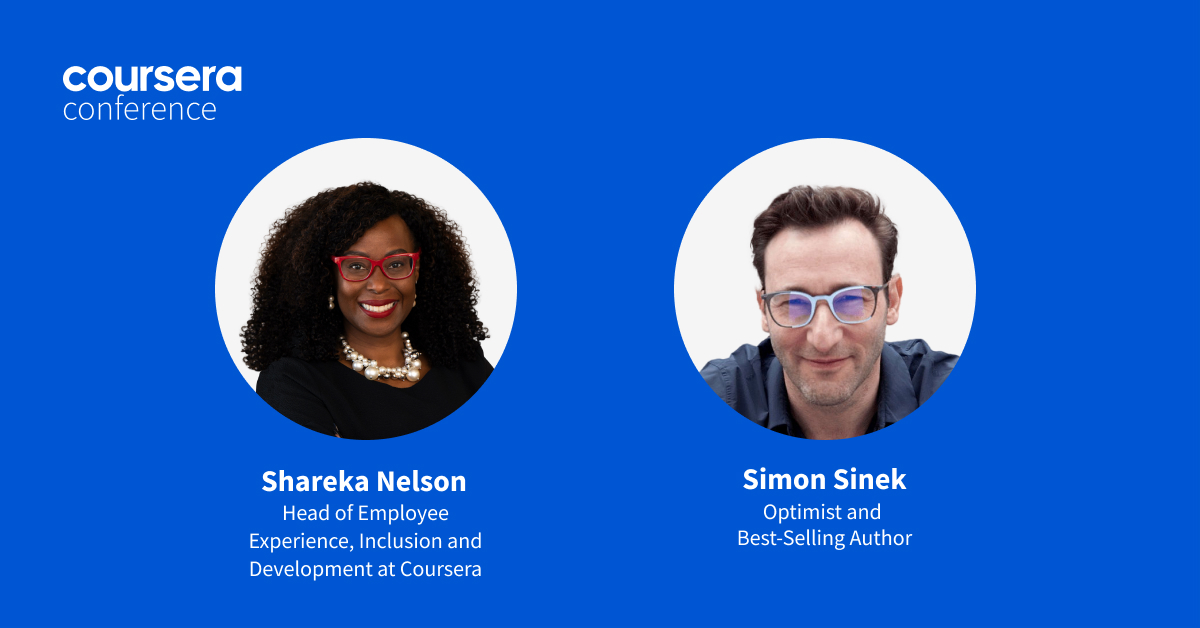
By Shareka Nelson
In my role as Coursera’s Culture and Development Leader, I’ve recently had the pleasure to welcome author, visionary, and thought leader Simon Sinek to the 10th annual Coursera Conference. In an exclusive 1:1 fireside chat, we discussed driving workplace change, learning as a vehicle for progress, and the role that diversity and inclusion play in enabling meaningful change for organizations.
Simon Sinek is the best-selling author of Start With Why, which started a movement to help people become more inspired at work, and in turn inspire their colleagues and customers. His TED talk on the topic has been watched by more than 28 million people, which makes it the third most popular TED video of all time.
If you missed the fireside chat, watch our fascinating conversation on-demand (but hurry, it’s only available until May 16), and read the main takeaways below.
Building a culture of learning
Why is proactively fostering change a safe business decision?
A lot of industries still haven’t quite figured out how to adapt their business model to the internet, even now. As a result, companies from the outside have come in and disrupted entire industries.
Take the movie industry, for example. Every single incumbent movie or television studio could have redefined the future of television with the rise of the internet. But they didn’t, they clung to their old business model.
Netflix tried to get Blockbuster to buy them, and Blockbuster’s CEO at the time wanted to experiment with streaming. The board, however, wouldn’t allow him to change the business model, because the company made 12 percent of its revenues from the fees it charged when customers returned their DVDs late. And now Blockbuster doesn’t exist. Just because you got away with something in the past doesn’t mean it’s going to work in the future.
What are the main barriers to building a culture of learning?
The world has changed, and if you don’t have a robust learning program to invest in, you’re setting yourself up for a catastrophe later when you realize you have no competitive advantage for why people will want to work for you.
Companies often don’t know where to start and say they don’t have the budget. But you can start anywhere. You can start with what you understand, and it doesn’t always have to cost a lot. Can you do a book club, for example? Make it voluntary, and every week or couple of weeks people get together and talk about the chapters of the book they have read.
The learning program can be homegrown. It doesn’t have to be complete straight away. Just ask who’s interested in the subject matter at hand, and you’ll be amazed at how many of your team members already study it. Invite them to share what they’re learning. Start with a little course to get an appetite for it and see how addictive it becomes once you start learning.
The more we learn, the more it benefits not just ourselves but the people around us – our colleagues and co-workers, our families, and all the people we love and care about. Fundamentally, to embrace a culture of learning is to embrace a life of service.
Developing diverse and inclusive talent
What role does diversity and inclusion play in enacting change?
Frankly, we can’t have effective change without diversity. How do we solve difficult problems if we surround ourselves with people who grew up like us, look like us, and sound like us? We’d end up with one or two points of view, which is only going to work for a short time.
Diverse points of view, on the other hand, lead to innovation and ultimately more profits. The amalgamation of ideas makes for much better solutions than the one-size-fits-all approach. It benefits organizations and also has cultural implications. The teams in these companies probably demonstrate better teamwork and more curiosity about each other’s ideas than judgment.
Where do companies typically get tripped up when it comes to implementing a DE&I strategy?
They trip up when they don’t ask for help and are just doing it to checkboxes. To enact systemic change, you need to recognize that it’s never going to be perfect. Don’t just hire a person to run a workshop, and that’s it. If you set it up as an event, we’re going to be judging you based on how successful that event was.
You need to be open about the fact that it’s a journey instead, which means you’re in a state of constant improvement, which is how all business cultures should be run anyway. It’s also important to be honest with yourself about the state of the company and how you got there to make sure you don’t repeat mistakes.
Future-proofing your team’s skillset
How can businesses understand what skills their workforce will need to thrive in the future?
You can’t predict the hard skills but there are some enduring human skills that will be necessary permanently. I hate the term soft skills. Hard and soft are opposites but these skills go together. If you get good at both, you become one of the most valuable members of the team. It’s a massive opportunity. Where most learning inside organizations is lacking is in human skills. They’ve doubled down on the hard skills but they’ve all but forgotten the human skills or think of them as soft, mushy, and disposable.
When technological changes upset the skill sets, we may have to even abandon one skill set and embrace a new one. Which team do you think will be more capable of adapting? It’s not the one without human skills where everyone fends for themselves. It’s the team that’s so skilled that they know how to come together, weather difficulty, and go through the change together.
Coursera Conference 2022 featured more than 40 sessions. You can catch on-demand sessions that you may have missed on the Coursera Conference website.
The post Why Change Matters: A Fireside Chat with Simon Sinek appeared first on Coursera Blog.
Free: 7-Days Trial from Coursera
Courses Available
The post Why Change Matters: A Fireside Chat with Simon Sinek appeared first on EduTravel.
[ad_2]Edutravel Malaysia Article

